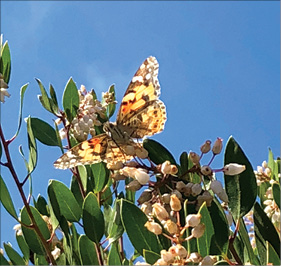Written by Tanya Kucak / Los Altos Town Crier
If you’re frustrated by habitat loss and climate change, and wonder if there’s anything you can do about it, there is – you can create habitat.
Plant native plants that support native pollinators, beneficial insects and birds in your neighborhood.
“Plants are the beginning of everything,” landscape architect Juanita Salisbury told me. Plant some natives, then “watch nature unfold and take over. Layers of complexity will happen.”
People all over the world – from Seattle to London, from Connecticut to Ottawa – have built pollinator corridors, pathways and ribbons. Closer to home, Salisbury has led the transformation of 10,000 square feet of unused land in Palo Alto into gorgeous habitat gardens in the past couple years.
All it takes is initiative, she said. Look around your neighborhood and find a neglected but easily accessible spot that’s not used for anything else.
“Thousands of square feet are going to waste in front of our doorsteps,” Salisbury said.
Parking strips along your street could become a pollinator corridor. City- or county-owned land with ivy or lawn could be transformed into beautiful gardens, colorful year-round, buzzing with life.
“We know better” than planting ivy, she said.
Assess the site, then approach the city with a detailed plan and an offer to plant, fund and maintain the site with volunteers.
“When you have a plan, it’s hard for people to say ‘no,’” she said. “Find a spot where they say ‘yes.’”
It won’t cost them anything, and “it will improve the town and make things look better,” Salisbury added.
Let the city use its money for something better than mowing lawns and maintaining ivy. In addition to donated materials, Salisbury has purchased plants and supplies with help from a GoFundMe site, a get-to-know-your-neighbor grant and Happy Hollow “Progress for Pollinators” grants.
POLLINATOR CORRIDORS
Salisbury delineated several rules of thumb for creating a pollinator corridor, stressing that “it’s easy.” They are:
• Follow the “rule of three” – three species each of early, middle and late bloomers, favoring locally appropriate native species.
• Plant each variety in masses that are at least 3 feet in diameter, because insects forage one species at a time.
• Leave some bare soil for ground-nesting native bees.
Although she is a landscape architect, Salisbury insisted that “anybody can do this. Plants are pretty forgiving, like nature is.” It does help to have one champion to steward the project.
Some of her favorites are manzanitas, ceanothus and native buckwheats. All require low water once they are established and come in many forms.
Salisbury also loves growing what she called “super rare” plants from seed, noting that “it’s a joy” to share something so precious.
One of the sites Salisbury planted had been “an eyesore for decades,” she said, with rat habitat (ivy) and random trash. It was transformed in a few weeks into a space with fragrance and color, visited by butterflies and a delight to the neighborhood.
Once the plants are in, establishing them takes some care for the first couple years. After that, minimal weeding once a month is all that’s needed, and eventually the natives will take over. Because you are fostering habitat and encouraging life, not creating a manicured garden, use a light hand. Prune late in the season to allow overwintering insects to emerge.
Tanya Kucak gardens organically. Email her at tanya.garden@gmail.com.



